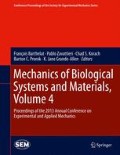Abstract
The dynamic analysis of a cultured cell using Finite Element Analysis is presented to understand the effect of vibration on a cell structure. The model of a spread cell on a culturing plate has been developed as a continuum model and a cellular tensegrity model. Using Finite Element modal analysis, natural frequencies and mode shapes of both models were obtained and compared with each other. Finite Element harmonic response analysis was carried out to investigate the dynamic response of a spread cell exposed to vibration in the frequency range of 1–60 Hz with 1 G acceleration. Both continuum model and tensegrity model showed that the first three natural frequencies appeared in range of 18 ~ 27 Hz and they were in the effective vibration frequency range for bone cell growth. In mode 1–3 the major oscillation was observed in horizontal direction and the resonance occurred when the base vibration frequency was closed to the calculated natural frequency. It is presumed that the optimal frequency for bone cell growth is closely related the natural frequency of cell structures and associated with the resonance of cellular structures. For better understanding resonance of cell structure future studies will consider the damping capability of cell structures.
Access this chapter
Tax calculation will be finalised at checkout
Purchases are for personal use only
References
Brown TD (2000) Techniques for mechanical stimulation of cells in vitro: a review. J Biomech 33(1):3–14
Hasegawa S, Sato S, Saito S, Suzuki Y, Brunette D (1985) Mechanical stretching increases the number of cultured bone cells synthesizing DNA and alters their pattern of protein synthesis. Calcif Tissue Int 37(4):431–436
Rosenberg N, Levy M, Francis M (2002) Experimental model for stimulation of cultured human osteoblast-like cells by high frequency vibration. Cytotechnology 39(3):125–130
Shikata T, Shiraishi T, Morishita S, Takeuchi R, Saito T (2008) Effects of amplitude and frequency of mechanical vibration stimulation on cultured osteoblasts. J Syst Des Dyn 2(1):382–388
Tanaka SM (1999) A new mechanical stimulator for cultured bone cells using piezoelectric actuator. J Biomech 32(4):427–430
McGarry J, Prendergast P (2004) A three-dimensional finite element model of an adherent eukaryotic cell. Eur Cell Mater 7:27–33
McGarry JG, Klein-Nulend J, Mullender MG, Prendergast PJ (2005) A comparison of strain and fluid shear stress in stimulating bone cell responses—a computational and experimental study. FASEB J 19(3):482–484
Abolfathi N, Karami G, Ziejewski M (2008) Biomechanical cell modelling under impact loading. Int J Model Simul 28(4):470–476
Charras GT, Horton MA (2002) Determination of cellular strains by combined atomic force microscopy and finite element modeling. Biophys J 83(2):858–879
Wee H, Voloshin A (2012) Modal analysis of a spreading osteoblast cell in culturing.In: Bioengineering conference (NEBEC), pp 1–2
Coughlin MF, Stamenovic D (1998) A tensegrity model of the cytoskeleton in spread and round cells. ASME J Biomech Eng 120:770–777
Single cell mechanobiology. http://www.nanofunction.org/single-cell-mechanobiology. Accessed 21 Jan 2012
Charras GT, Horton MA (2002) Single cell mechanotransduction and its modulation analyzed by atomic force microscope indentation. Biophys J 82(6):2970–2981
Chauhan AK, Varma AA (2009) Textbook of molecular biotechnology
Freitas RA (1999) Nanomedicine, vol I, Basic capabilities. Landes Bioscience Georgetown, Austin
ANSYS Element Reference, ANSYS Inc (2009)
ANSYS Theory Reference for the Mechanical APDL and Mechanical Applications, ANSYS Inc (2009)
Author information
Authors and Affiliations
Corresponding author
Editor information
Editors and Affiliations
Rights and permissions
Copyright information
© 2014 The Society for Experimental Mechanics, Inc.
About this paper
Cite this paper
Wee, H., Voloshin, A. (2014). Dynamic Analysis of a Spread Cell Using Finite Element Method. In: Barthelat, F., Zavattieri, P., Korach, C., Prorok, B., Grande-Allen, K. (eds) Mechanics of Biological Systems and Materials, Volume 4. Conference Proceedings of the Society for Experimental Mechanics Series. Springer, Cham. https://doi.org/10.1007/978-3-319-00777-9_19
Download citation
DOI: https://doi.org/10.1007/978-3-319-00777-9_19
Published:
Publisher Name: Springer, Cham
Print ISBN: 978-3-319-00776-2
Online ISBN: 978-3-319-00777-9
eBook Packages: EngineeringEngineering (R0)

